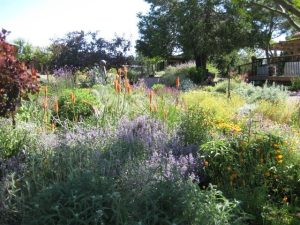I love the hardy, flowering perennials I’ve planted in large beds over the years, but they’re all either deciduous or die back completely to the ground in winter. So this year, I’ve decided to explore the world of evergreen, heat- and drought-tolerant groundcovers as bedding fillers and in barren spots around my lot.
Drought-tolerant evergreen groundcovers that thrive in our foothills climate and soil offer a goldmine of low-maintenance, attractive landscaping options with many benefits. They need far less water than many ornamentals. They often require little or no fertilizer or products to battle diseases and pests. Many spread quickly, so gardeners don’t have to break the bank to get great swaths of them. They help stop erosion and act as a mulch to cool the soil and conserve moisture. They are often attractive to wildlife. And my personal favorite, they crowd out weeds.
One thing to keep in mind even with drought-tolerant groundcovers is that like any young plants in your landscape, they need more water the first year or two in order to develop a strong root system to survive periods of drought.
Following are either western native or drought-tolerant groundcovers that make light work of routine gardening. Most are one to 12 inches tall, but a few can reach 24 inches. Unless otherwise noted, they prefer full sun to light shade. Depending on the variety, their winter hardiness zones range from 4 to 9.
Creeping Thyme (Thymus). This ground-hugging herb is a classic choice for planting between pavers, but they’re also great in drifts, border edging, and as fillers in beds. They average one to two inches high. The most common selections in cultivation are creeping wild thyme (T. serpyllum), Azores thyme (T. caespititius), lemon thyme (T. x citriodorus), caraway thyme (T. herba-barona) and woolly thyme (T.praecox subsp. britannicus). Creeping wild thyme is covered with small pink flowers in late spring to summer.
Stonecrop (Sedum). This is a large (400-plus species) of succulent. A few popular varieties include: “Angelina,” with delicate whorls of green to yellow leaves reminiscent of pine needles, only in miniature; “Firecracker,” with tiny, oval, burgundy leaves that form what look like dense flowers; and “Tricolor,” with green leaves edged in pink and white.
Dwarf Coyote Brush (Baccharis pilularis). Once a popular landscaping ground cover in new housing developments, this wide-spreading plant to a foot tall is still a winner. It’s covered in dense, rounded, bright-green leaves. Some sport tiny white or yellow flowers in summer. “Pigeon Point” is a common variety.
Creeping Mahonia (Mahonia Repens). Also called “Oregon Grape,” this native plant is one of our very best evergreen groundcovers for shade and partial shade. Growing 12 to 18 inches tall, its late spring, fragrant yellow flowers are followed by clusters of purple berries in summer.
Carpet Manzanita (Arctostaphylos hybrid). No list of drought-tolerant, evergreen ground covers would be complete without this ubiquitous—but lovely—native. “Emerald Carpet” is the most popular variety, reaching a height of 10 to 16 inches. It has small, dense, glossy leaves are joined by tiny urn-shaped white or pink flowers in spring.
This is just a short list of evergreen groundcovers suited for foothills gardens. Check out the UC California Garden Web for many more: https://cagardenweb.ucanr.edu.
Rachel Oppedahl is a University of California Cooperative Extension Master Gardener of Tuolumne County.

